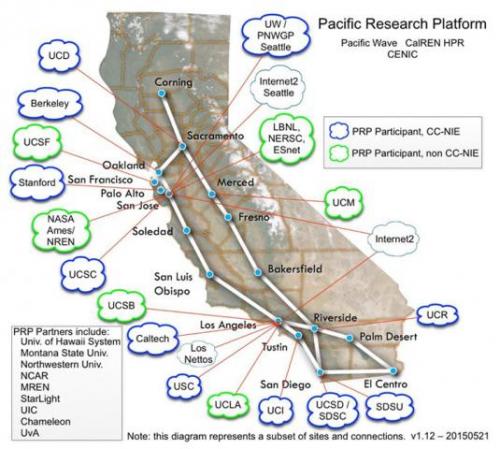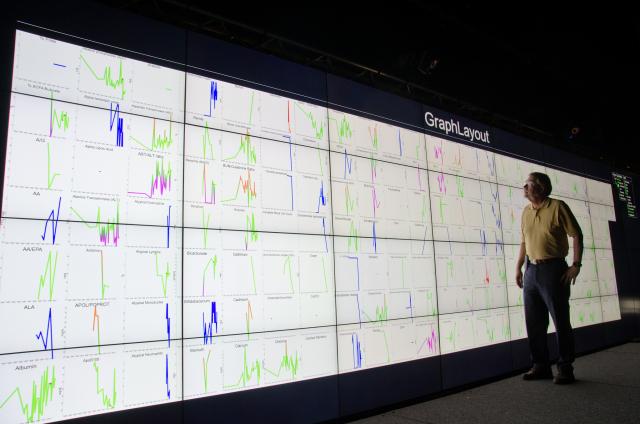
UC San Diego , UC Berkeley lead creation of West Coast big data freeway system
 For the last three years, the National Science Foundation (NSF) has made a series of competitive grants to over 100 U.S. universities to aggressively upgrade their campus network capacity for greatly enhanced science data access. NSF is now building on that distributed investment by funding a $5 million, five-year award to UC San Diego and UC Berkeley to establish a Pacific Research Platform (PRP), a science-driven high-capacity data-centric “freeway system” on a large regional scale. Within a few years, the PRP will give participating universities and other research institutions the ability to move data 1,000 times faster compared to speeds on today’s inter-campus shared Internet.
For the last three years, the National Science Foundation (NSF) has made a series of competitive grants to over 100 U.S. universities to aggressively upgrade their campus network capacity for greatly enhanced science data access. NSF is now building on that distributed investment by funding a $5 million, five-year award to UC San Diego and UC Berkeley to establish a Pacific Research Platform (PRP), a science-driven high-capacity data-centric “freeway system” on a large regional scale. Within a few years, the PRP will give participating universities and other research institutions the ability to move data 1,000 times faster compared to speeds on today’s inter-campus shared Internet.
The PRP’s data sharing architecture, with end-to-end 10-100 gigabits per second (Gb/s) connections, will enable region-wide virtual co-location of data with computing resources and enhanced security options. PRP links most of the research universities on the West Coast (the 10 University of California campuses, San Diego State University, Caltech, USC, Stanford, University of Washington) via the Corporation for Education Network Initiatives in California (CENIC)/Pacific Wave’s 100G infrastructure. To demonstrate extensibility PRP also connects the University of Hawaii System, Montana State University, the University of Illinois at Chicago, Northwestern, and the University of Amsterdam. Other research institutions in the PRP include Lawrence Berkeley National Laboratory (LBNL) and four national supercomputer centers (SDSC-UC San Diego, NERSC-LBNL, NAS-NASA Ames, and NCAR). In addition, the PRP will interconnect with the NSF-funded Chameleon NSFCloud research testbed and the Chicago StarLight/MREN community.
 “Research in data-intensive fields is increasingly multi-investigator and multi-institutional, depending on ever more rapid access to ultra-large heterogeneous and widely distributed datasets,” said UC San Diego Chancellor Pradeep K. Khosla. “The Pacific Research Platform will make it possible for PRP researchers to transfer large datasets to where they work from their collaborators’ labs or from remote data centers.” (Pictured l-r: PI Larry Smarr, co-PIs Camille Crittenden, Phil Papadopoulos, Tom DeFanti, and Frank Würthwein.)
“Research in data-intensive fields is increasingly multi-investigator and multi-institutional, depending on ever more rapid access to ultra-large heterogeneous and widely distributed datasets,” said UC San Diego Chancellor Pradeep K. Khosla. “The Pacific Research Platform will make it possible for PRP researchers to transfer large datasets to where they work from their collaborators’ labs or from remote data centers.” (Pictured l-r: PI Larry Smarr, co-PIs Camille Crittenden, Phil Papadopoulos, Tom DeFanti, and Frank Würthwein.)
Fifteen existing multi-campus data-intensive application teams act as drivers of the PRP, providing feedback over the five years to the technical design staff. These application areas include accelerator particle physics, astronomical telescope survey data, gravitational wave detector data analysis, galaxy formation and evolution, cancer genomics, human and microbiome ‘omics integration, biomolecular structure modeling, natural disaster, climate, CO2 sequestration simulations, as well as scalable visualization, virtual reality, and ultra-resolution video. The PRP will be extensible both across other data-rich research domains as well as to other national and international networks, potentially leading to a national and eventually global data-intensive research cyberinfrastructure.
 “To accelerate the rate of scientific discovery, researchers must get the data they need, where they need it, and when they need it,” said UC San Diego computer science and engineering professor Larry Smarr (right), principal investigator of the PRP and director of the California Institute for Telecommunications and Information Technology (Calit2). “This requires a high-performance data freeway system in which we use optical lightpaths to connect data generators and users of that data.”
“To accelerate the rate of scientific discovery, researchers must get the data they need, where they need it, and when they need it,” said UC San Diego computer science and engineering professor Larry Smarr (right), principal investigator of the PRP and director of the California Institute for Telecommunications and Information Technology (Calit2). “This requires a high-performance data freeway system in which we use optical lightpaths to connect data generators and users of that data.”
CSE Chair Rajesh Gupta said, “We are proud that a member of our department faculty, Larry Smarr, is once again providing visionary leadership on a large-scale project that will have a transformative impact on national cyberinfrastructure. PRP envisions a practical distributed architecture supporting a wide range of disciplines to ensure that federally funded university research advances science and continues to produce extraordinary talent for generations to come.”

